10 Best Carbon Avoidance Offsets (Complete 2024 List)
Impactful Ninja is reader-supported. When you buy through links on our site, we may earn an affiliate commission.
Learn more
Learn more
.
Hey fellow impactful ninja ? You may have noticed that Impactful Ninja is all about providing helpful information to make a positive impact on the world and society. And that we love to link back to where we found all the information for each of our posts. Most of these links are informational-based for you to check out their primary sources with one click. But some of these links are so-called "affiliate links" to products that we recommend. First and foremost, because we believe that they add value to you. For example, when we wrote a post about the environmental impact of long showers, we came across an EPA recommendation to use WaterSense showerheads. So we linked to where you can find them. Or, for many of our posts, we also link to our favorite books on that topic so that you can get a much more holistic overview than one single blog post could provide. And when there is an affiliate program for these products, we sign up for it. For example, as Amazon Associates, we earn from qualifying purchases. First, and most importantly, we still only recommend products that we believe add value for you. When you buy something through one of our affiliate links, we may earn a small commission - but at no additional costs to you. And when you buy something through a link that is not an affiliate link, we won’t receive any commission but we’ll still be happy to have helped you. When we find products that we believe add value to you and the seller has an affiliate program, we sign up for it. When you buy something through one of our affiliate links, we may earn a small commission (at no extra costs to you). And at this point in time, all money is reinvested in sharing the most helpful content with you. This includes all operating costs for running this site and the content creation itself. You may have noticed by the way Impactful Ninja is operated that money is not the driving factor behind it. It is a passion project of mine and I love to share helpful information with you to make a positive impact on the world and society. However, it's a project in that I invest a lot of time and also quite some money. Eventually, my dream is to one day turn this passion project into my full-time job and provide even more helpful information. But that's still a long time to go. Stay impactful,Affiliate Disclosure
Why do we add these product links?
What do these affiliate links mean for you?
What do these affiliate links mean for us?
What does this mean for me personally?
![]()
Carbon avoidance practices are a proactive way of preventing carbon dioxide (CO2) from entering our atmosphere. Partnered with carbon offsets, carbon avoidance could play a crucial role in mitigating climate change. So, we had to ask: what are the best carbon avoidance offsets?
The best carbon avoidance offsets are offered by Terrapass, Native Energy, Carbonfund, and Ecologi which offer REDD+, waste management, energy efficiency, and certain types of agricultural offsets. In addition, REDD.plus, CoreZero, and Del Agua specialize in specific types of avoidance offsets.
Keep reading to learn more about the best carbon offsets for carbon avoidance, how these carbon offset projects work, what their respective offsetting costs are, and what your best way would be to offset your carbon emissions. At the end of the article, we’ll also share with you what the biggest carbon offsetting limitations are and why reducing your carbon footprint is more effective than offsetting it.
Here’s What All the Best Carbon Avoidance Offsets Have in Common
Carbon offsets are reductions in carbon emissions that are used to compensate for carbon emissions occurring elsewhere. They are measured in tons of CO2 equivalents and are bought and sold through international brokers, online retailers, and trading platforms on what is known as the global carbon offset market.
“Carbon offset: a way for a company or person to reduce the level of carbon dioxide for which they are responsible by paying money to a company that works to reduce the total amount produced in the world, for example by planting trees”
Oxford Dictionary
Carbon avoidance is the prevention of future carbon emissions via particular carbon offsets or via direct carbon reduction measures. It is one form of carbon reduction,
“Avoidance: not doing something; preventing something from existing or happening”
Oxford Dictionary
Carbon offsets that are commonly classified as carbon avoidance measures include:
- Reducing Emissions from Deforestation and Forest Degradation (REDD+)
- Waste Management
- Energy efficiency
- Agriculture
Purchasing carbon avoidance offsets funds carbon emission reduction projects that prevent CO2 from entering the atmosphere. It is a proactive, rather than a reactive, way of dealing with carbon emissions.
These Are the 10 Best Carbon Avoidance Offsets in 2024
Below are our favorite carbon avoidance offsets (you can click on their link to directly jump to their section in this article):
| Carbon Avoidance Offsets | Quick Facts |
| Terrapass | About: Carbon offset purchases support third-party certified REDD+, waste management, and agricultural projects. Costs: $16.51-$17.63 per 1,000kg of CO2 |
| Native Energy | About: Carbon offset purchases support third-party certified REDD+, waste management, and agricultural projects. Costs: $18 per 1,000 kg of CO2 |
| Carbonfund | About: Carbon offset purchases support third-party certified REDD+, waste management, and energy-efficiency projects. Costs: $16.25-$17.16 per 1,000kg of CO2 for individuals, $390-$1,560 per year for small businesses, determined after initial contact for large businesses |
| Ecologi | About: Carbon offset purchases support third-party certified REDD+, waste management, and energy-efficiency projects. Costs: $6.04 per 1,000 kg of CO2 offset |
| REDD.plus | About: Carbon offset purchases support UNFCCC-verified REDD+ projects around the globe. REDD.plus is a central registry and exchange for REDD+ Result Units, a type of carbon credit. Costs: $16 per ton of CO2 |
| CoreZero | About: Purchases support waste management projects including food rescue, upcycling, waste-to-energy, and composting. Costs: Costs are determined after initial contact |
| DelAgua | About: Purchases support the Rwandan clean cookstoves energy-efficiency carbon offset project. Costs: Costs are determined after initial contact |
| Wildlife Works | About: Carbon offset purchases support third-party certified carbon offset projects including The Kasigau Corridor, Mai Ndombe, and Southern Cardamom REDD+ projects in Kenya, Cambodia, and Colombia respectively. Costs: $20 per ton of CO2 |
| GreenTech | About: They take plastic (e.g., plastic bottles) and sort, grind, wash, and process it into sustainable recycled flakes to make products (e.g., PET flakes, PET straps, and r-PET granules). Costs: $40 per 1,000kg of CO2 |
| South Pole | About: Carbon offset purchases support third-party certified waste management and energy-efficiency projects. Costs: Costs are determined after initial contact |
Terrapass: A Variety of Carbon Offsets for Individuals and Businesses
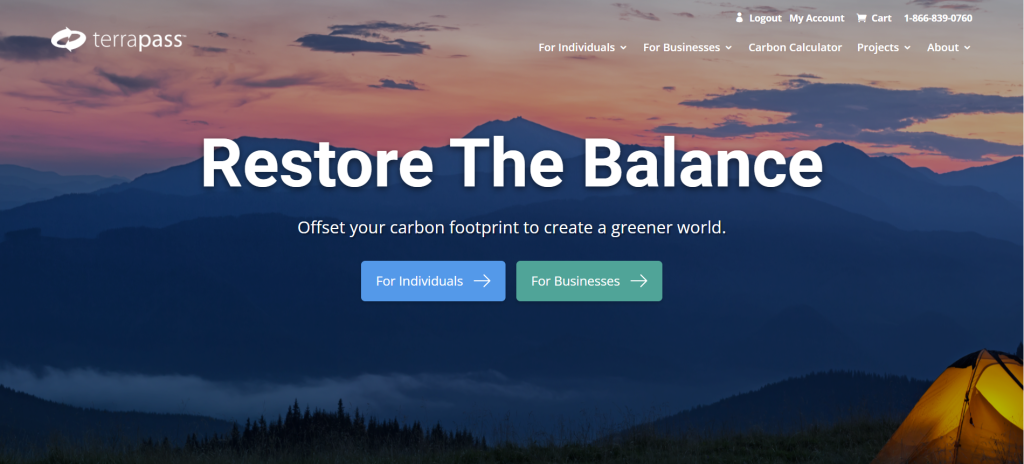
Terrapass was founded in 2004 by Dr. Karl Ulrich to reduce as many carbon emissions as possible via the use of education, online tools, carbon offsets, and renewable energy. Today, they provide verified landfill gas capture, farm power, renewable energy, and forestry carbon offsets for individuals and businesses.
“Restore the balance.”
Terrapass
Project overview: Terrapass rotates through its projects, but they have offered a variety of carbon avoidance offsets including:
- REDD+: The Cordillera Azul National Park REDD+ Project, which avoids deforestation in four areas of central Peru.
- Waste Management: The Greater New Bedford Landfill Gas Utilization Project, which captures landfill gas and converts it to energy.
- Agriculture: The Scenic View Dairies and George DeRuyter and Sons Dairy projects, which involve capturing methane (CH4) and generating electricity from livestock manure.
Carbon offset effectiveness: Terrapass uses the Verified Carbon Standard, Gold Standard, American Carbon Registry, and the Climate Action Reserve to help ensure transparency and quality in the creation, quantification, and verification of their projects.
Carbon offset costs: Individual carbon offsets range from $16.51-$17.63 per 1,000kg of CO2, and business carbon offsets cost approximately $16.99 per 1,000kg of CO2.
How to get your carbon offsets: You can visit their website to learn more about their carbon avoidance offset projects and then purchase your offsets either as an individual or a business.
Native Energy: Changing the World Through Climate Projects
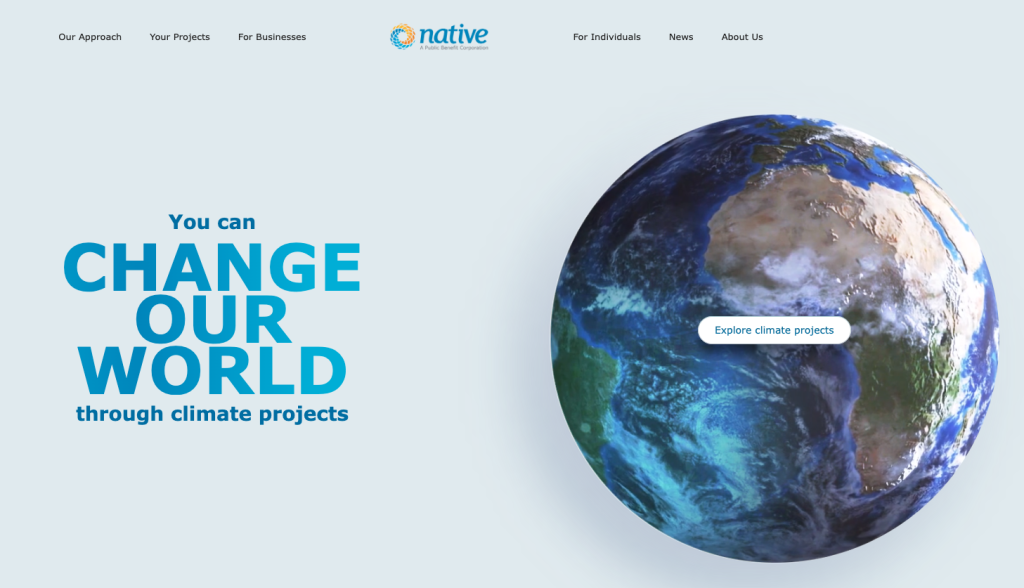
Native Energy was founded in 2000 by Jeff Bernicke as a platform for organizations to implement projects that reduce greenhouse gas emissions and combat climate change.
Today, they offer carbon offsets and renewable energy solutions that provide clients the opportunity to invest and enable the development of new climate projects with direct business benefits.
“Envision your ideal climate solution. Let us build it.”
Native
Carbon offset credit overview: Native Energy supports a range of carbon avoidance projects including:
- REDD+: REDD in the Yaeda Valley, which avoids deforestation in Tanzania.
- Waste Management: From Waste to Fuel – Improving Agriculture and Livelihoods in Uganda, Bi-County Municipal Landfill, Clinton County Landfill, which generates biofuel and converts CH4 gas into energy.
- Agriculture: Noblehurst Family Farm Project, Schrack Family Farm Project, and May Ranch Avoided Grassland Conversion Project, which involves farm methane power and avoided grassland conversion.
Carbon offset credit effectiveness: Native Energy’s offsets are certified by one of the following leading standards: Gold Standard, Verified Carbon Standard, Climate Action Reserve, American Carbon Registry, Plan Vivo, Climate, or the Community & Biodiversity Alliance.
Carbon offset costs: Carbon offsets cost approximately $18 per ton of CO2.
How to get your Carbon offsets: You can visit their website to learn more and purchase your carbon avoidance offsets.
Carbonfund: Energy Efficiency, Forestry, and Renewable Energy Offsets
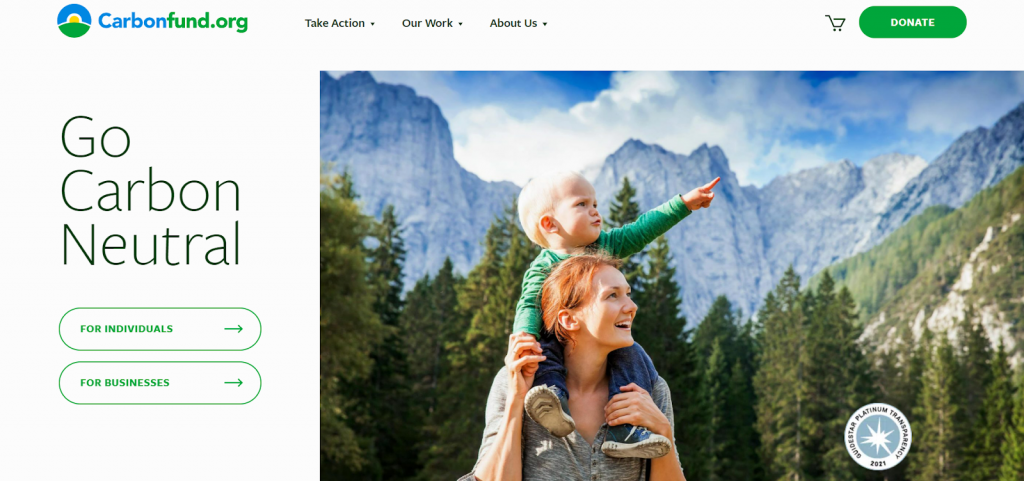
Carbonfund was founded in 2003 by Eric Carlson to make it easy for any individual, business, or organization to reduce and offset their climate impact. Today, they have been incorporated into ClimeCo and provide verified energy efficiency, renewable energy, and forestry carbon offsets for individuals and businesses.
“Reduce what you can, offset what you can’t.”
Carbonfund
Carbon offset overview: Carbonfund supports a variety of carbon avoidance offset projects including:
- REDD+: The Purus Project, The Russas-Valparaiso Project, and The Envira Amazonia Project, all avoid deforestation in Brazil.
- Waste Management: The New Bedford Landfill gas-to-renewable energy and Seneca Meadows landfill waste management projects are located in the US.
- Energy efficiency : The Kenya Burn Stoves Project, Aqua Clara Water Filtration Programme, South Korea Waste Energy Co-Generation Project, and Truck Stop Electrification Project, which involve clean cooking, water filtering, and reducing tailpipe emissions.
Carbon offset effectiveness: Carbonfund uses the Verified Carbon Standard, Gold Standard, American Carbon Registry, and Climate Action Reserve to help ensure transparency and quality in the creation, quantification, and verification of offset projects.
Carbon offset costs: Individual carbon offsets range from $16.25-$17.16 per 1,000kg of CO2, small business carbon offsets range from $390-$1,560 per year (dependent on the number of employees), and large business carbon offset costs are evaluated after personal contact.
How to get your carbon offsets: You can visit their website to purchase your individual or business carbon avoidance offsets.
Ecologi: A Global Carbon Offset Portfolio
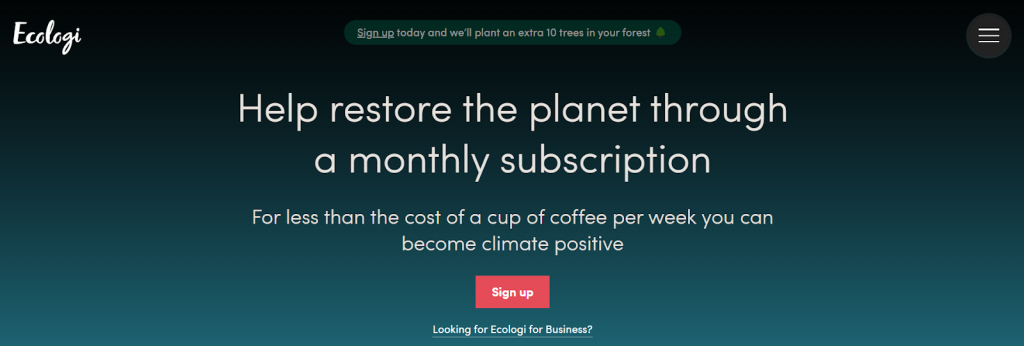
Ecologi was founded in 2019 by Elliot Coad, Lucy Jack, and Alex Price as an answer to the question “What if I put the money from my morning coffee into climate action”? Today, they have funded over 57 million trees, avoided over 2 million tons of carbon, and continue to enable everyday people to tackle the current climate crisis via reforestation and carbon offsetting projects.
“For less than the cost of a cup of coffee per week, you can become climate positive.”
Ecologi
Project overview: Ecologi supports a range of carbon avoidance projects globally including:
- REDD+: The Southern Cardamom REDD+ Project and The Kariba REDD+ Project, which avoid deforestation in Cambodia and Zimbabwe.
- Waste Management: Turning local organic waste into electricity in India, Capturing waste biogas for energy in Turkey, and avoiding CH4 emissions from landfills in Brazil.
- Energy efficiency: Distributing cleaner cookstoves in Kenya, high-efficiency cookstoves in Tanzania, cleaner cookstoves in Zambia and Ghana, and fuel-efficient cookstoves in Honduras.
Carbon offset effectiveness: Ecologi’s carbon offsetting projects are certified by either the Gold Standard, Verified Carbon Standard, or the Climate, Community, & Biodiversity Standards. And they also have an interactive Google sheet where you can check when, where, and how many trees are planted through their platform.
Carbon offset costs: It costs approximately $6.04 per 1,000 kg of CO2 offset. Ecologi has a personal offset plan where you choose how many trees get planted (12, 24, or 48) for a price ($10.50, $21, or $42 per month).
How to get your carbon offsets: You can visit Ecologi’s website to select your personal carbon offset plan and get your carbon avoidance offsets.
REDD.plus: A Central Registry and Exchange for REDD+ Result Units
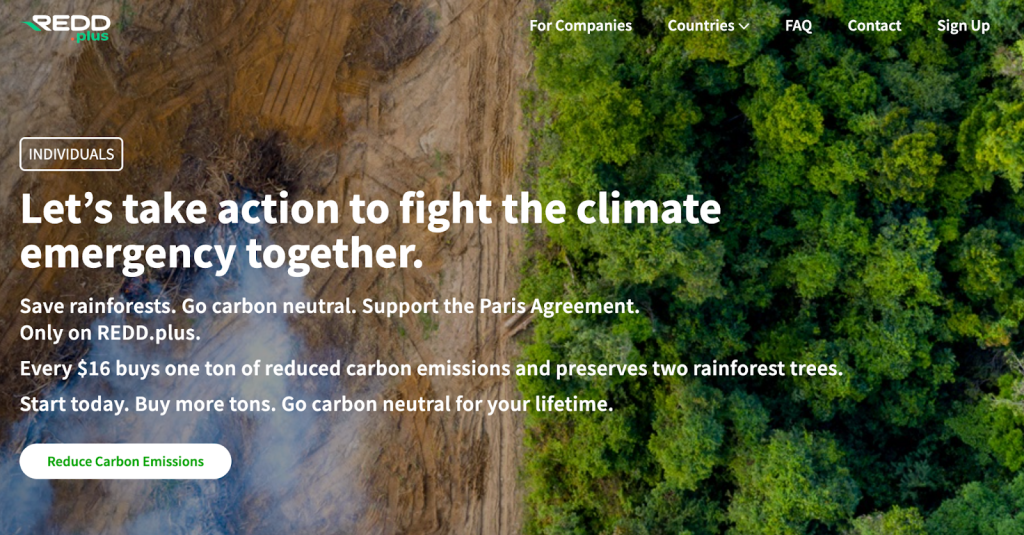
REDD.plus was founded by the Coalition for Rainforest Nations to give individuals and businesses the ability to purchase carbon emissions reductions generated by verified REDD+ projects. Today, they manage the creation of and platform on which REDD+ carbon credits are sold in order to reduce deforestation and prevent further degradation.
“Let’s take action to fight the climate emergency together”
REDD.plus
Project overview: REDD.plus is a project of the Coalition for Rainforest Nations, which consists of over 50 rainforest nations. The basis of REDD.plus is the REDD+ Result Unit (RRU), which is a type of carbon credit. A country’s national government develops a REDD+ strategy, the results of which are independently verified and published on a central hub. Serialized RRUs can then be purchased on the REDD.plus platform or CBL markets. Every RRU purchased saves 2 rainforest trees, and over 90% of your purchase goes back to the countries and local communities that are protecting rainforests around the world.
Carbon offset effectiveness: A country’s national government issues each RRU to prevent leakage and double-counting, REDD+ results are independently verified and published on the UNFCCC Info Hub, and each RRU is retired once it has been sold.
Carbon offset costs: Each RRU costs $16 and offsets 1 ton of CO2 emissions. RRUs are available for purchase as a one-time or monthly purchase.
How to get your carbon offsets: You can visit the REDD.plus website to purchase your RRUs.
CoreZero: Food Rescue and Upcycling
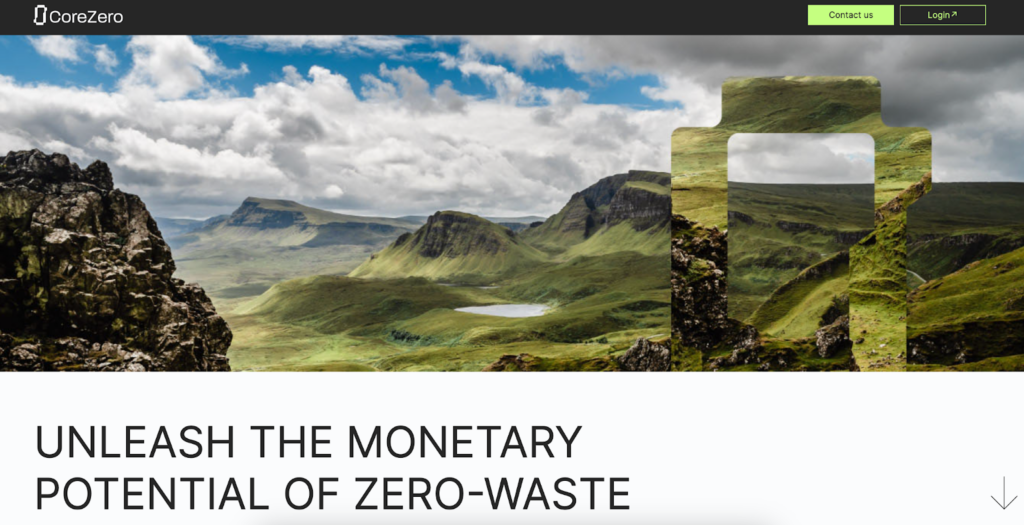
CoreZero was founded in 2020 by Jean Pierre Azañedo and Ignacio Bordigoni as a way to reduce global waste and methane (CH4) emissions. Today, they monetize food rescue, upcycling, waste-to-energy, and composting projects through carbon credits.
“Unleash the monetary potential of zer0-waste.”
CoreZero
Carbon offset overview: CoreZero generates carbon credits in a few different ways, including via food banks, upcycling, composting, and wastewater treatment plants. They work directly with food banks to rescue food before it can become waste. They also create carbon credits based on the environmental impact of wastewater treatment plants, which can encourage organizations to invest more in the technology.
Carbon offset effectiveness: CoreZero’s offsets are verified by an independent third party and, depending on the specific offset, are certified by either the Verified Carbon Standard, Gold Standard, American Carbon Registry, or the Global Carbon Council.
Carbon offset costs: Costs are determined after initial contact.
How to get your carbon offsets: You can visit CoreZero’s website and contact a representative to get your carbon offsets.
DelAgua: Experts in Carbon Development Projects
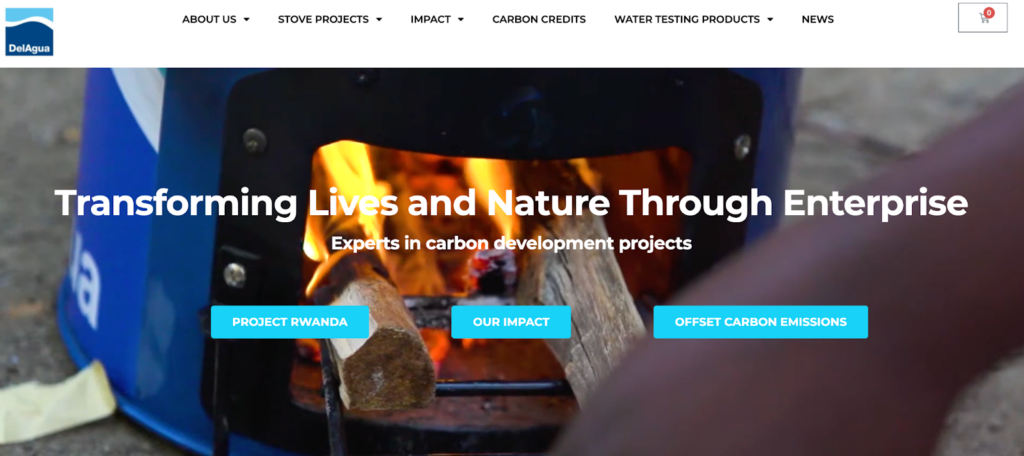
DelAgua was founded in 1985 as a water testing company aimed at providing clean water to rural African communities. Today, their water testing kit is used in 150+ countries and they offer carbon credits from a pioneer Rwandan clean cookstoves project.
“Transforming lives and nature through enterprise”
DelAgua
Carbon offset overview: DelAgua launched the Rwandan clean cookstoves project in partnership with the Government of Rwanda in 2013 to transform the lives and environment of rural African communities. To date, the project has provided over 6 million Rwandans with 1.3 million stoves, free of charge. The stoves use small twigs and branches, which people can collect without cutting down trees, thereby reducing deforestation and using 71% less wood than a traditional fire. It is one of the largest programs of its kind which has helped pull families from poverty and avoid CO2 emissions.
Carbon offset effectiveness: Del Agua’s carbon offset projects are certified by the Verified Carbon Standard. They are also aligned with the Paris Agreement and adhere to multiple UN Sustainable Development Goals.
Carbon offset costs: Costs are determined after initial contact.
How to get your carbon offsets: You can visit DelAgua’s website and contact a representative to get your energy-efficiency carbon offsets.
Wildlife Works: A Market-Based Conservation Model
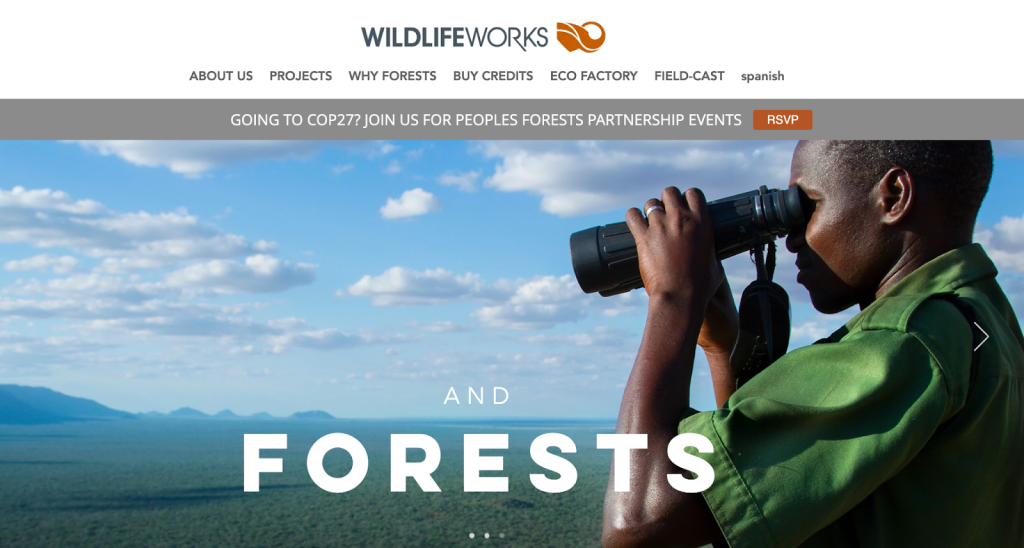
Wildlife Works was founded in 1997 by Mike Korchinsky to help communities transition from extraction-based to conservation-based livelihoods. Today, they develop and manage REDD+ projects in Kenya, Cambodia, and Colombia to combat deforestation and create sustainable livelihoods.
“Biodiversity-driven. Community-centered. Ecosystem-based.”
Wildlife Works
Project overview: Wildlife Works has developed the Kasigau Corridor, Mai Ndombe, and Southern Cardamom REDD+ projects in Kenya, Cambodia, and Colombia, respectively. Altogether, they protect over 2.4 million acres of rainforest and create jobs and other livelihoods other than poaching and deforestation.
Carbon offset effectiveness: The Kasigau Corridor project is verified by the CCBS at gold level, the Mai Ndombe project is verified by Verra, and the Southern Cardamom project is verified by Verra and the CCBS at gold level. Each of the 3 projects also adheres to multiple UN Sustainable Development Goals.
Carbon offset costs: Carbon offsets cost approximately $20 per ton of CO2.
How to get your carbon offsets: You can visit Wildlife Works’ webpage to view their REDD+ projects and purchase your carbon credits.
GreenTech: Plastic Waste Conversion

GreenTech was founded in 2002 as an offshoot of GreenGroup, Europe’s largest integrated recycling park. Today, they recycle over 100,000 tons of plastic per year, helping to reduce CO2 emissions and improve the lives of the communities they serve.
“Responsibility for nature is everyone’s duty”
GreenTech
Carbon offset overview: GreenTech is the first European recycling company to be endorsed by the Gold Standard for their issuance of polyethylene terephthalate (PET) recycling carbon credits. They take plastic (e.g., plastic bottles) and sort, grind, wash, and process it into sustainable recycled flakes to make products (e.g., PET flakes, PET straps, and r-PET granules). This results in up to 60% less CO2 emissions compared to manufacturing products from virgin inputs.
Carbon offset effectiveness: GreenTech’s offsets are certified by the Gold Standard and adhere to multiple UN Sustainable Development Goals.
Carbon offset costs: It costs approximately $40 per 1,000kg of CO2 offset.
How to get your carbon offsets: You can visit their website to purchase your waste management carbon offsets.
South Pole: Providing the Tools to Achieve a Low-Carbon Reality
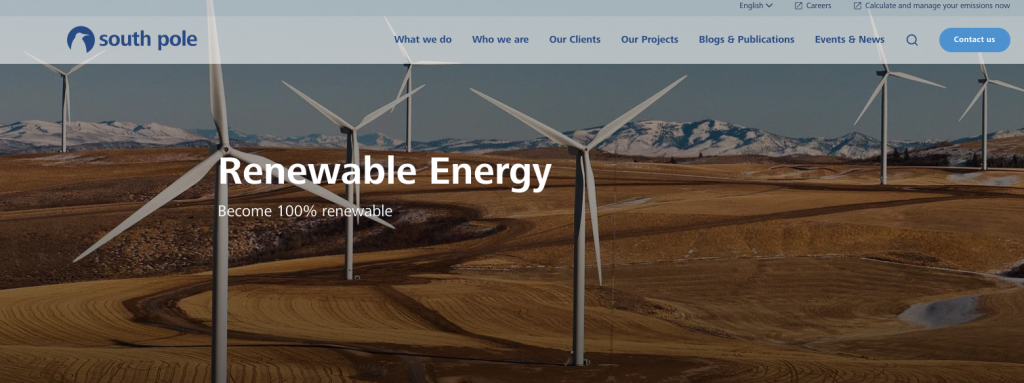
South Pole was founded in 2006 by 5 graduate students from the Swiss Federal Institute of Technology (ETH) as a platform to confront climate change. Today, they offer a wide variety of climate solutions including carbon offsets, environmental credits, and renewable energy credits (RECs).
“From ambition to action”
South Pole
Carbon offset overview: South Pole has a portfolio of over 800 verified carbon offset projects including a variety of carbon avoidance offsets involving:
- Waste Management: The Kenyan Smart biogas system, Nakhon Biogas, and Vietstar Sustainable Waste Treatment projects.
- Energy efficiency: The WWF Nature Clean Cookstoves in China, Bamako Clean Cookstoves in Mali, and Efficient Cookstoves in Rwanda projects.
Carbon offset effectiveness: South Pole’s carbon offset projects are certified by either the Verified Carbon Standard, Gold Standard, American Carbon Registry, or Climate Action Reserve. They are also aligned with the Paris Agreement and the United Nations Sustainable Development Goals.
Carbon offset costs: Costs are determined after initial contact.
How to get your carbon offsets: You can visit South Pole’s website and contact a representative to get your energy-efficiency carbon offsets.
How Effective and Efficient Are Carbon Avoidance Offsets
In terms of effectiveness, carbon avoidance offsets can help reduce deforestation and strengthen our natural carbon sinks, reduce methane emissions and other forms of pollution, bolster energy security, and help transition away from fossil fuels. However, they can lack additionality and they do not reduce your own carbon emissions, which can lead to greenwashing.
In terms of efficiency, carbon avoidance offsets are proactive and relatively cost-effective; however, they can also be difficult to monitor and verify and they are not yet scaled to compensate for our global emissions.
Carbon avoidance offsets are effective at mitigating climate change because:
- Carbon avoidance offsets involving REDD+, energy efficiency, and agriculture protect forest and grassland ecosystems and their ability to act as carbon sinks.
- Carbon avoidance offsets involving waste management, energy efficiency, and agriculture reduce methane (CH4) emissions and combat land, air, and water pollution.
- Carbon avoidance offsets involving waste management and energy efficiency can help reduce reliance on biomass and fossil fuels, leading to increased energy security and energy independence.
However, carbon avoidance offsets involving REDD+, waste management, and energy efficiency can also lack additionality due to uncertainty in determining baselines and increasing demand for projects.
Carbon avoidance offsets are efficient at reducing CO2 emissions because:
- Carbon avoidance offsets cut emissions at their source, making them a proactive way of dealing with emissions.
- Carbon avoidance offsets involving REDD+, waste management, energy efficiency, and agriculture are some of the most cost-effective methods of carbon emission reduction.
However, carbon avoidance offsets can also lack efficiency because:
- The decentralized nature and many different types of energy-efficiency and agricultural carbon avoidance offsets can make standardization and monitoring difficult.
- Waste management and agricultural carbon avoidance offsets are not yet scaled to compensate for the billions of tons of greenhouse gasses (GHGs) we emit annually.
In addition, carbon avoidance offsets do not reduce your own carbon emissions, which can lead to greenwashing. This occurs when emissions are only offset and not reduced from the source, and the consumer is deceived into thinking they are offsetting their emissions but in reality, they are not. This is why we should first reduce our emissions before relying on offsets.
What Are The 6 Pros and 4 Cons of Carbon Avoidance Offsets
Carbon avoidance offsets are a proactive, relatively cost-effective way of dealing with CO2 emissions that can protect existing carbon sinks, bolster energy security, help transition away from fossil fuels, and reduce various forms of pollution. Carbon avoidance offsets also allow us to reduce carbon emissions in ways we wouldn’t be able to accomplish individually.
Carbon avoidance offsets can lack additionality, standardization, and monitoring, and are not yet scaled to compensate for our global waste emissions. They also do not reduce your own carbon emissions, which can lead to greenwashing.
What Are the 6 Pros of Carbon Avoidance Offsets
Carbon avoidance offsets have various pros that make them effective at proactively reducing carbon emissions.
| Pros of Carbon Avoidance Offsets | Quick Facts |
| #1: Carbon avoidance offsets are proactive | Carbon avoidance is a proactive, rather than reactive, way of dealing with emissions. By eliminating emissions at the source, we cut down on fossil fuel (e.g., coal, oil, and natural gas) usage. |
| #2: Carbon avoidance offsets can protect existing carbon sinks | Carbon avoidance offsets involving REDD+, energy-efficiency, and agriculture protect forest and grassland ecosystems and their ability to act as carbon sinks. |
| #3: Carbon avoidance offsets can be relatively cost-effective | REDD+, waste management, energy efficiency, and agricultural carbon offsets are some of the most cost-effective methods of carbon emission reduction. |
| #4: Carbon avoidance offsets can bolster energy security and help transition away from fossil fuels | Waste management and energy-efficiency projects reduce overall energy demand, which in turn reduces reliance on imports of biomass fuels or fossil fuels. Being able to produce your own energy without relying on other entities increases energy security, and increased energy security fosters energy independence. |
| #5: Carbon avoidance offsets can reduce methane emissions and other forms of pollution | Waste management and farm power agricultural offsets can reduce CH4 emissions via CH4 capture, combustion, or conversion to energy projects. They can also target land, air, or water pollution, depending on the project. |
| #6: Carbon avoidance offsets allow us to reduce carbon emissions in ways we wouldn’t be able to accomplish individually | Carbon avoidance offsets allow us to reduce emissions from activities where sustainable alternatives are not yet widely available. |
What Are the 4 Cons of Carbon Avoidance Offsets
Understanding the drawbacks of carbon avoidance offsets is important when implementing this strategy on a large scale in order to mitigate climate change.
| Cons of Carbon Avoidance Offsets | Quick Facts |
| #1: Carbon avoidance offsets can lack additionality | Carbon avoidance offsets involving REDD+, waste management, and energy efficiency can lack additionality due to uncertainty in determining baselines and increasing demand for projects |
| #2: Carbon avoidance offsets can lack standardization and monitoring | The decentralized nature and many different types of energy-efficiency and agricultural carbon avoidance offsets can make standardization and monitoring difficult. |
| #3: Carbon avoidance offsets are not yet scaled to compensate for our global emissions | Because waste management and agricultural offsets are only a small subsection of the larger carbon offset market, they are inadequate in terms of offsetting our global emissions. |
| #4: Carbon avoidance offsets do not reduce your own carbon emissions, which can lead to greenwashing | If emissions are only offset and not reduced from the source, this could lead to greenwashing, when the consumer is deceived into thinking they are offsetting their emissions but in reality, they are not. |
How Can Carbon Avoidance Offsets Help Mitigate Climate Change
Climate change is a severe and long-term consequence of fossil fuel combustion. Carbon avoidance offsets can help mitigate climate change because they cut emissions at their source, which is a proactive way of dealing with carbon emissions. If left untreated, these emissions can remain in our atmosphere for tens of thousands of years and exacerbate the negative effects of climate change.
How is Climate Change Defined
Climate change is arguably the most severe, long-term global impact of fossil fuel combustion. Every year, approximately 33 billion tons (bt) of CO2 are emitted from burning fossil fuels. The carbon found in fossil fuels reacts with oxygen in the air to produce CO2.
“Climate change: changes in the earth’s weather, including changes in temperature, wind patterns and rainfall, especially the increase in the temperature of the earth’s atmosphere that is caused by the increase of particular gasses, especially carbon dioxide.”
Oxford Dictionary
Atmospheric CO2 fuels climate change, which results in global warming. When CO2 and other air pollutants absorb sunlight and solar radiation in the atmosphere, it traps the heat and acts as an insulator for the planet. Since the Industrial Revolution, Earth’s temperature has risen a little more than 1 degree Celsius (C), or 2 degrees Fahrenheit (F). Between 1880-1980 the global temperature rose by 0.07C every 10 years. This rate has more than doubled since 1981, with a current global annual temperature rise of 0.18C, or 0.32F, for every 10 years.
As outlined in the 2015 Paris Climate Agreement, we must cut current GHG emissions by 50% by 2030 and reach net zero by 2050.
How Do Carbon Offsets Generally Help Mitigate Climate Change
Levels of carbon in our atmosphere that cause climate change have increased as a result of human emissions since the beginning of the Industrial Revolution in 1750. The global average concentration of carbon dioxide in the atmosphere today registers at over 400 parts per million. Carbon offsets can help prevent these levels from increasing even more.
When you hear the words “carbon offset”, think about the term “compensation”. Essentially, carbon offsets are reductions in GHG emissions that are used to compensate for emissions occurring elsewhere.
Carbon offsets that meet key criteria and verified project standards, are additional and permanent, and are part of projects that are carried out until the end of their lifespan have the best chance of reducing carbon emissions and therefore reducing climate change.
When we offset CO2 we also slow the rate of global temperature rise, which in turn minimizes the effects of climate change.
How Do Carbon Avoidance Offsets Specifically Help Mitigate Climate Change
Carbon avoidance offsets proactively deal with CO2 emissions. Rather than removing emissions once they have already been emitted, carbon avoidance focuses on approaches that prevent CO2 from being released in the first place.
As outlined in the 2015 Paris Climate Agreement, we must cut current greenhouse gas (GHG) emissions by 50% by 2030 and reach net zero by 2050. Carbon avoidance is important to meet these targets because the more we avoid carbon, the less we emit into our atmosphere.
Final Thoughts
The best carbon avoidance offsets are offered by Terrapass, Native Energy, Carbonfund, and Ecologi which offer REDD+, waste management, energy efficiency, or certain types of agricultural offsets. In addition, REDD.plus, CoreZero, Del Agua, Wildlife Works, and GreenTech specialize in specific avoidance offsets. South Pole offers a variety of avoidance offsets for individuals and businesses.
Carbon avoidance offsets are a specific type of carbon offset that focuses on preventing carbon emissions from entering our atmosphere. But for all of the good carbon offsets can instigate, they should not be seen as the only solution to climate change. They are effective at reducing CO2 in the short term, but in the long term, they fail to reduce CO2 enough.
When used in conjunction with direct CO2 reduction measures, carbon offsetting can be much more effective. We should reduce our own carbon footprint as much as possible first, and only then choose the most effective carbon avoidance offsets.
Stay impactful,

Sources
- U.S. Environmental Protection Agency: Offsets and RECs -What’s the Difference?
- Britannica: Carbon Offset
- David Suzuki Foundation: Are carbon offsets the answer to climate-altering flights?
- The Climate Trust: Avoidance and Removal Offsets are Needed Equally
- ClimateSeed: The difference between carbon removal and carbon avoidance
- GreenBiz: REC vs. Carbon Offset: Do You Know the Difference?
- Impactful Ninja: What Are REDD+ Carbon Offsets and How Do They Work
- Impactful Ninja: What Are Energy Efficiency Carbon Offsets and How Do They Work
- Impactful Ninja: What Are Waste Management Carbon Offsets and How Do They Work
- Impactful Ninja: What Are Agricultural Carbon Offsets and How Do They Work
- Terrapass: Homepage
- Terrapass: About Terrapass
- Terrapass: Cordillera Azul National Park REDD+
- Terrapass: Greater New Bedford Landfill Gas Utilization Project
- Terrapass: Scenic View Dairies
- Terrapass: George DeRuyter and Sons Dairy
- Verra: Verified Carbon Standard
- The Gold Standard: Homepage
- American Carbon Registry: Homepage
- Climate Action Reserve: Homepage
- Terrapass: Solutions for Individuals
- Terrapass: Solutions for Businesses
- Native Energy: Homepage
- Native Energy: Mission & Values
- Native Energy: Climate Projects
- Native Energy: REDD in the Yaeda Valley
- Native Energy: From Waste to Fuel – Improving Agriculture and Livelihoods in Uganda
- Native Energy: Bi-County Municipal Landfill
- Native Energy: Clinton County Landfill
- Native Energy: Noblehurst Family Farm Project
- Native Energy: Schrack Family Farm Project
- Native Energy: May Ranch Avoided Grassland Conversion Project
- Plan Vivo: Homepage
- Climate, Community & Biodiversity Alliance: Homepage
- Native Energy: Buy Carbon Offsets
- Carbonfund: Homepage
- ClimeCo: Homepage
- Carbonfund: About Us
- Carbonfund: Projects
- Carbonfund: The Purus Project
- Carbonfund: The Russas-Valparaiso Project
- Carbonfund: The Envira Amazonia Project
- Carbonfund: New Bedford Landfill gas-to-renewable energy
- Carbonfund: Seneca Meadows landfill
- Carbonfund: Kenya Burn Stoves Project
- Carbonfund: Aqua Clara Water Filtration Programme
- Carbonfund: South Korea Waste Energy Co-Generation Project
- Carbonfund: Truck Stop Electrification Project
- Carbonfund: For Individuals – Offset Your Carbon Footprint
- Carbonfund: Our Forestry/Reforestation Projects
- Carbonfund: Become a Small Business Partner
- Carbonfund: Become a Large Business Partner
- Ecologi: Homepage
- Ecologi: Your Plan
- Ecologi: Reforestation and Carbon Avoidance Projects
- Ecologi: The Southern Cardamom REDD+ Project
- Ecologi: The Kariba REDD+ Project
- Ecologi: Turning local organic waste into electricity in India
- Ecologi: Capturing waste biogas for energy in Turkey
- Ecologi: Avoiding methane emissions from landfill in Brazil.
- Ecologi: Distributing cleaner cookstoves in Kenya
- Ecologi: High efficiency cookstoves in Tanzania
- Ecologi: Cleaner cookstoves in Zambia and Ghana
- Ecologi: Fuel efficient cookstoves in Honduras
- Ecologi: Ecologi Public Impact and Operations Ledger
- REDD.plus: Homepage
- Coalition for Rainforest Nations: Homepage
- United Nations Framework Convention on Climate Change: Info Hub – REDD+
- Xpansiv: Homepage
- REDD.plus: FAQ and Help Center
- REDD.plus: Corporations
- REDD.plus: Individuals
- CoreZero: Homepage
- LinkedIn: CoreZero – About
- Global Carbon Council: Homepage
- CoreZero: Contact Us
- DelAgua: Homepage
- DelAgua: Project Rwanda
- DelAgua: Carbon Credits
- United Nations Convention Framework on Climate Change: The Paris Agreement
- United Nations Department of Economic and Social Affairs: The 17 Goals
- Wildlife Works: Homepage
- Wildlife Works: History
- Wildlife Works: Wildlife Works REDD+ Projects Around the World
- Wildlife Works: Wildlife Works Kasigau Corridor Kenya REDD+ Project
- Wildlife Works: Mai Ndombe Wildlife Works REDD+ Developer
- Wildlife Works: Cambodia S. Cardamoms
- Wildlife Works: Wildlife Works and the Sustainable Development Goals
- Wildlife Works: Buy Credits
- GreenTech: Homepage
- GreenGroup: Homepage
- GreenTech: Reducing CO2
- GreenTech: Gift Certificates
- South Pole: Homepage
- South Pole: Climate Action Projects
- South Pole: South Pole has developed over 700 climate action projects
- South Pole: Biodigesters for Kenyan Farmers
- South Pole: Vietstar Sustainable Waste Treatment
- South Pole: Nakhon Biogas
- South Pole: WWF Clean Cookstoves
- South Pole: Bamako Clean Cookstoves
- South Pole: Efficient Cookstoves
- South Pole: Contact South Pole Today
- National Geographic: Deforestation
- ClientEarth: What is a carbon sink?
- US Environmental Protection Agency: Importance of Methane
- The World Counts: World Waste Facts
- US Energy Information Administration: Biomass Explained
- International Energy Agency: Energy security – Reliable, affordable access to all fuels and energy sources
- US Environmental Protection Agency: Summary of the Energy Independence and Security Act
- Carbon Offset Guide: Additionality
- International Institute for Environment and Development: REDD: Protecting climate, forests and livelihoods
- United States Environmental Protection Agency: Distributed Generation of Electricity and its Environmental Impacts
- Yale Environment 360: Is the ‘Legacy’ Carbon Credit Market a Climate Plus or Just Hype?
- Edie: Carbon offsetting – How are businesses avoiding greenwashing on the road to net-zero?
- Impactful Ninja: How Effective and Efficient Are Carbon Avoidance Offsets? Here Are the Facts
- Impactful Ninja: Carbon Avoidance Offsets: All 6 Pros and 4 Cons Explained
- Impactful Ninja: What Is the Carbon Footprint of Fossil Fuels? A Life-Cycle Assessment
- World Nuclear Association: Carbon Emissions from Electricity
- Natural Resources Defense Council: Global Warming 101
- myclimate: What does “net zero emissions” mean?
- National Oceanic and Atmospheric Administration: Climate Change – Atmospheric Carbon Dioxide
- Natural Resources Defense Council: Carbon Offsets 101
- Terrapass: Carbon Offset Projects
- Carbon Offset Guide: Additionality
- Carbon Offset Guide: Permanence




